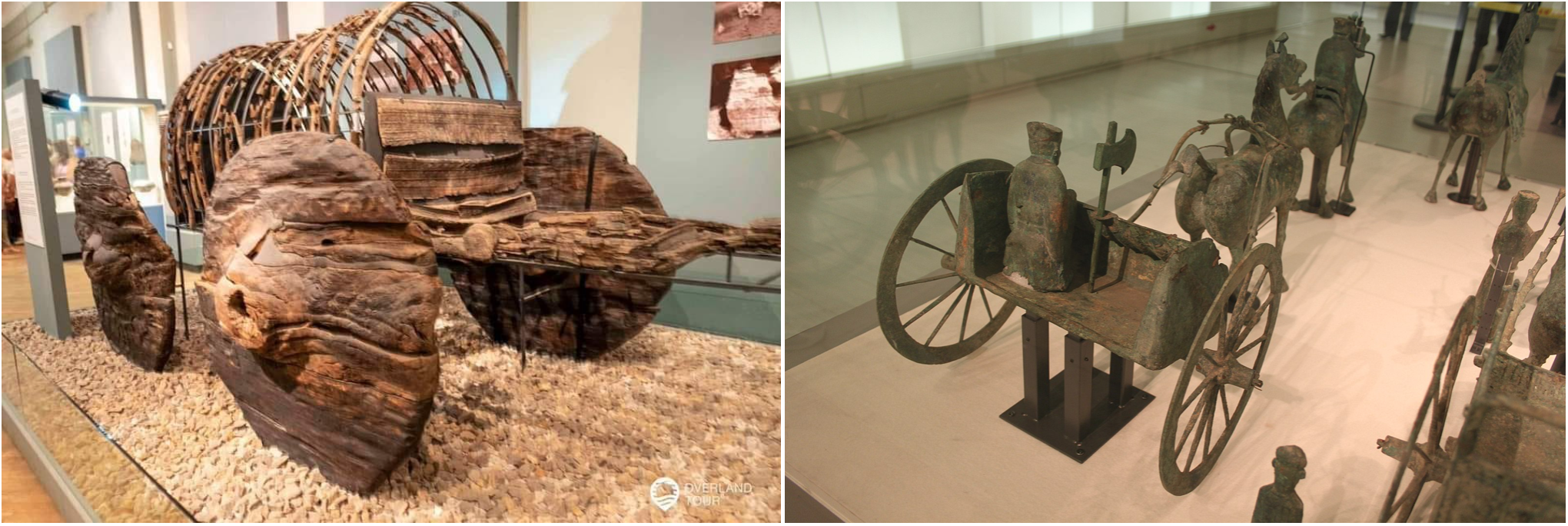
Chariots and carts in ancient Armenia and ancient China
by Ani Margaryan
The Lchashen Settlement, located in modern-day Armenia, has long captivated archaeologists as a fascinating Bronze Age structure. In the 1950s, a necropolis was uncovered in the area, containing approximately 800 tombs presumed to have belonged to the upper class. The graves contained buried bulls, horses, and valuable artifacts, all of which indicate the high status of those interred. Of particular interest were human skeletons found sitting in carts or chariots adorned with intricate designs and inscriptions. These carts and chariots were believed to be the means by which the deceased were transported to the afterlife. Remarkably well-preserved chariots or carts were unearthed during the excavation, some of which are thought to be the oldest wagons in the world, dating back 4,000 years.
One of these oak-made chariot-wagons is presently on display at the History Museum of Armenia. Twelve chariot-wagons in excellent condition have been discovered in total, dating back to 2000 BCE. Additionally, two-yoke chariots with 28-spoke wheels and an open body were found in Lchashen as well as in other necropolises from the same period. Notably, specific burial mounds only contained certain parts of chariots, such as the yoke or some of its components.
Publications exploring the topic of wheeled transport, such as Beverley Davis’s “Timeline of the Development of the Horse” and Stuart Piggott’s “The Earliest Wheeled Transport: From the Atlantic Coast to the Caspian Sea,” have featured the wagons, with both noting that the Lchashen Settlement chariots are the earliest known chariots from the Bronze Age. The discovery of the Lchashen Settlement, its accompanying tombs, and associated artifacts have provided valuable insights into the lives and rituals of Bronze Age elites, contributing to our understanding of early wheeled transport development.
In ancient China, written sources attribute the use of the chariot to a minister named Xi Chong during the Xia dynasty, with the chariot being deployed during the Battle of Gan in the 21st century BCE. It is believed that the chariot was introduced around 1200 BC, during King Wu Ding’s reign of the Shang dynasty. This dating is based on a unique artifact known as a “bow-shaped implement,” which was discovered in several chariot pits. These artifacts have also been found in more readily datable contexts, such as the Tomb of Fu Hao, where oracle-bone inscriptions provide a reliable date.
While a formidable weapon in China until the end of the Warring States period, other weapons such as the crossbow, massed infantry, standard cavalry units, and nomadic cavalry eventually replaced chariots. However, chariots continued to serve as command posts for officers during the Qin and Han dynasties, while armored chariots were used by the Han dynasty against the Xiongnu Confederation in the Han-Xiongnu War.
Some scholars suggest that the chariot was not a Chinese invention but was imported from the Caucasus via Central Asia. This theory is supported by the discovery of wheeled vehicles in the Lchashen Settlement in Armenia, which is located in the Caucasus region. The use of chariots in other parts of the world, such as in Egypt, Greece, and India, further suggests that the development of wheeled transport was not a singular event but rather a gradual process that took place in different parts of the world over an extended period.








